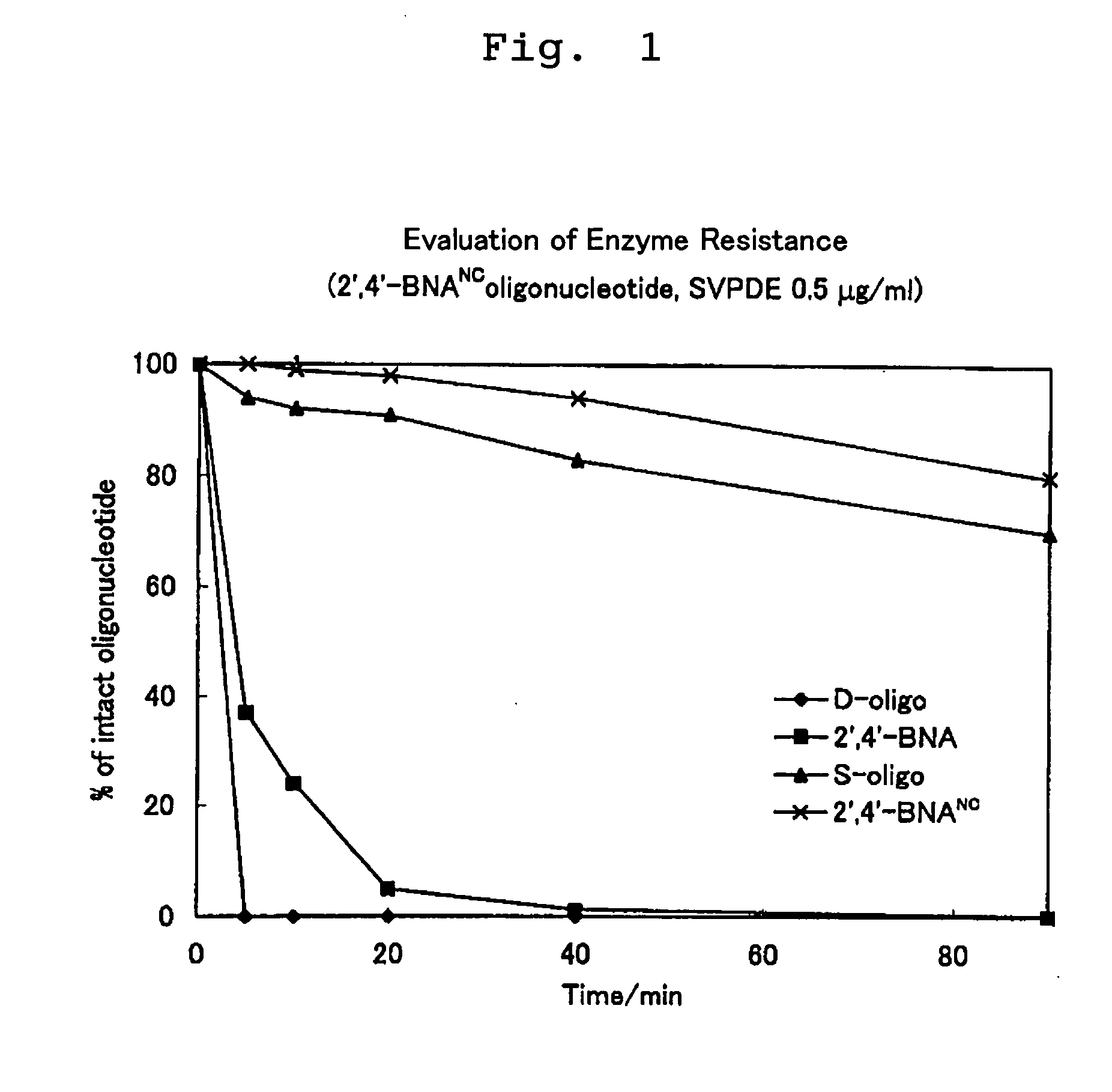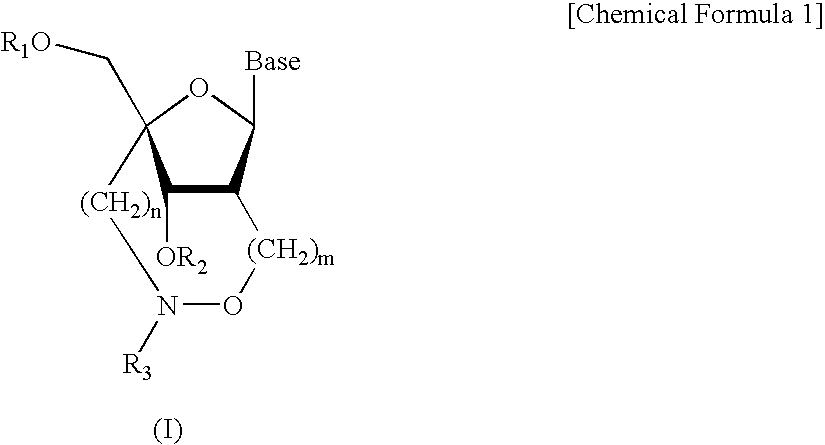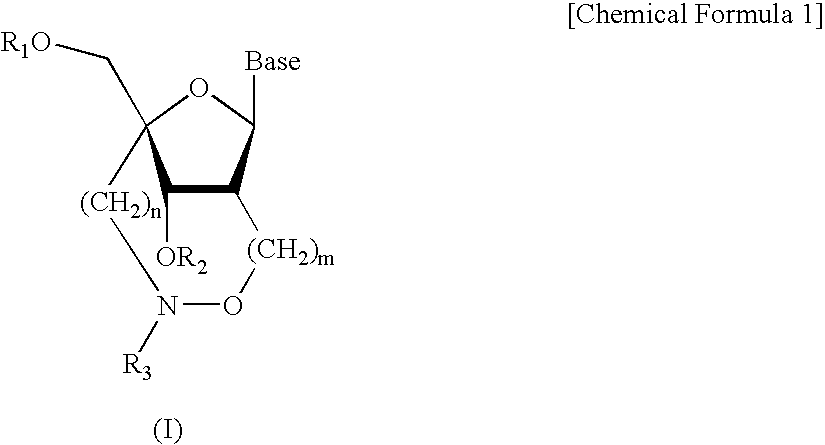Novel artificial nucleic acids of n-o bond crosslinkage type
- Summary
- Abstract
- Description
- Claims
- Application Information
AI Technical Summary
Benefits of technology
Problems solved by technology
Method used
Image
Examples
example 1
Synthesis of Nucleoside Analogues (2′,4′-BNANC Amidites)
[0084] (1) Synthesis of Compound 2
[0085] A 40% aqueous solution of methylamine (0.11 ml, 1.50 mmols) was added to a tetrahydrofuran solution (3.5 ml) of Compound 1 (49 mg, 0.073 mmol) shown in the above synthesis scheme under ice-cooled conditions, and the mixture was stirred for 3 hours at room temperature. After the solvent of the reaction solution was distilled off, the residue was extracted with ethyl acetate, and the organic layer was washed with water and a saturated aqueous solution of sodium chloride. The organic layer was dried over anhydrous sodium sulfate, and the solvent was distilled off. Then, the residue was purified by silica gel column chromatography (n-hexane:ethyl acetate=1:1) to obtain Compound 2 (45 mg, 99%) as a white solid.
[0086] [Equation 1]
[0087] mp 64-66° C. 1H-NMR (CDCl3) δ: 1.62 (3H, s), 2.43 (3H, s), 3.10 (1H, br), 3.63, 3.71 (2H, AB, J=10 Hz), 4.18 (2H, s), 4.24 (1H, d, J=6 Hz), 4.33 (1H, dd, J=...
example 2
Synthesis and Purification of Oligonucleotide Analogues
[0192] (1) Synthesis of 2′,4′-BNANC Modified Oligonucleotides
[0193] Oligonucleotide analogues (1) to (22) containing 2′,4′-BNANC monomer units were synthesized by an automated nucleic acid synthesizer Expedite™ 8909 (ABI) on a 0.2 mmol scale in accordance with a standard phosphoroamidite protocol. The coupling time for the amidite and the 5′-terminal hydroxyl group was set at 94 seconds for the natural nucleoside amidite and at 300 seconds for the 2′,4′-BNANC amidites (16, 17 and 21).
[0194] For the 2′,4′-BNANC modified oligonucleotides having the 5′-terminal protected with a DMTr group and supported in a solid phase, removal (1.5 h) from a column using 28% aqueous ammonia was performed. The removed oligonucleotide analogues were reacted for 16 hours at 60° C. in 28% aqueous ammonia for deprotection of all protective groups.
[0195] Simple purification by an NAP-10 column was carried out, and respective fractions obtained were ...
experimental example 1
Measurement of Melting Points (Tm) of 2′,4′-BNANC Modified Oligonucleotides (Evaluation of Duplex-Forming Capacity)
[0200] The oligonucleotide analogues (1) to (5) and (13) to (17) synthesized in the Examples (i.e., antisense strands), and a sense strand of a natural DNA or RNA oligonucleotide were annealed. The melting points (Tm) of the annealing products were measured to investigate the duplex-forming capacity of the antisense strands.
[0201] Sample solutions (500 μL) with end concentrations of NaCl 100 mM, sodium phosphate buffer (pH 7.2) 10 mM, antisense strand 4 μM, and sense strand 4 μM were bathed in boiling water, and cooled down to room temperature over the course of 10 hours. A stream of nitrogen was flowed through a cell chamber of a spectrophotometer (Beckman, DU-650) to prevent dew formation, and the sample solutions were gradually cooled down to 5° C. Further, the sample solutions were maintained at 10° C. for 20 minutes, and then their measurements were started. The ...
PUM
| Property | Measurement | Unit |
|---|---|---|
| Electrical resistance | aaaaa | aaaaa |
| Fluorescence | aaaaa | aaaaa |
| Affinity | aaaaa | aaaaa |
Abstract
Description
Claims
Application Information
 Login to View More
Login to View More - R&D
- Intellectual Property
- Life Sciences
- Materials
- Tech Scout
- Unparalleled Data Quality
- Higher Quality Content
- 60% Fewer Hallucinations
Browse by: Latest US Patents, China's latest patents, Technical Efficacy Thesaurus, Application Domain, Technology Topic, Popular Technical Reports.
© 2025 PatSnap. All rights reserved.Legal|Privacy policy|Modern Slavery Act Transparency Statement|Sitemap|About US| Contact US: help@patsnap.com



